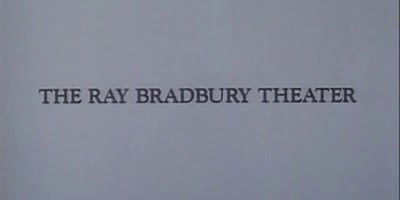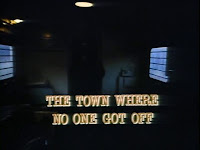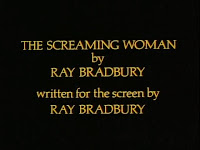The 1980’s was an
excellent time for enthusiasts of the anthology format on television. I can
certainly count myself as one of those, as my total inability to follow an
ongoing narrative over twelve or possibly twenty four episodes testifies. It’s
hard to pinpoint where this renewed interest began; perhaps it was the big
screen success of such films as Creepshow
(1982) and Twilight Zone: The Movie (1983). Certainly the latter would have been
instrumental in the resurrection of The
Twilight Zone (1985-89), and the former might have played a large part in
George A. Romero’s thinking when he set up Tales
from the Darkside (1984-88). In addition to The Twilight Zone in colour, we also got to see a re-colourised
Alfred Hitchcock introduce a whole new batch of episodes as Alfred Hitchcock Present (1985-89) made a return.
Other anthology shows that took their bow in the 1980’s included Amazing Stories (1985-87), The Hitchhiker (1983-91), Monsters (1988-91), Tales from the Crypt (1989-96),
Hammer House of Horror (1980),
Freddy’s Nightmares (1988-90) and Friday the 13th – The Series
(1987-90) to name but a few.
 One area which would
provide rich pickings was the bibliography of Ray Bradbury, which dated back to
the 1940’s and encompassed hundreds of short stories which were perfect for the
new found popularity of the anthology format. With a filmed introduction by
Bradbury himself (in a study surrounded by the paraphernalia of his short
stories) and all episodes adapted for the screen by Bradbury, this hand on
approach ensured a good deal of fidelity to the original stories. The show was
originally picked up by HBO, who broadcast the first three episodes in mid 1985
and the next three episodes in February 1986. The DVD release wisely conflated
these two mini-seasons into one six episode season. After which the programme
was picked up by USA Network and broadcast for an additional four seasons
between 1988 and 1992. In total sixty five episodes were produced, and here is
my humble effort to catalogue and review them...Welcome to the world of The Ray Bradbury Theater.
One area which would
provide rich pickings was the bibliography of Ray Bradbury, which dated back to
the 1940’s and encompassed hundreds of short stories which were perfect for the
new found popularity of the anthology format. With a filmed introduction by
Bradbury himself (in a study surrounded by the paraphernalia of his short
stories) and all episodes adapted for the screen by Bradbury, this hand on
approach ensured a good deal of fidelity to the original stories. The show was
originally picked up by HBO, who broadcast the first three episodes in mid 1985
and the next three episodes in February 1986. The DVD release wisely conflated
these two mini-seasons into one six episode season. After which the programme
was picked up by USA Network and broadcast for an additional four seasons
between 1988 and 1992. In total sixty five episodes were produced, and here is
my humble effort to catalogue and review them...Welcome to the world of The Ray Bradbury Theater.
Episode 1 –
MARIONETTES, INC. (21/05/1985)
Director – Paul Lynch
The opening episode of The Ray Bradbury Theatre is an
appropriate choice as it explores one of Bradbury’s key thematic
preoccupations; the conflict between man and machine and mankind’s increasing
reliance on technology. Marionettes, Inc.
first appeared in print in Bradbury’s excellent and memorable 1951 anthology The Illustrated Man, which itself was
made into a rather lacklustre film in 1969 featuring Rod Steiger. It was first adapted
for the screen for the fourth season of Alfred
Hitchcock Presents and re-titled Design
for Loving and was a clear influence on such later films as The Stepford Wives (1975). Bradbury’s wry sense of humour is in evidence
throughout; from the clinging and suffocating behaviour of Mrs. Braling (Jayne
Eastwood) who as it turns out is only desperate for her love to be reciprocated,
to the stylised absurdity of Leslie Nielsen’s performance as the CEO of
Marionettes, Inc. However this episode belongs to James Coco as Braling, who at
first seems trapped and put upon, but emerges as a cold, selfish and jealous
individual who is punished for his lack of empathy and warmth towards his
doting wife. In a neat little subplot
Bradbury also illustrates that it is not only husbands that can make use of
Fantoccini’s skills in artificial intelligence. This episode was directed by
British filmmaker Paul Lynch who proved his skills in the horror genre with the
enjoyable slasher flick Prom Night
(1980), and the significantly less enjoyable Humungous (1982). His later career would largely be spent in
television.
Episode 2 – THE
PLAYGROUND (04/06/1985)
Director – William
Fruet
The second episode of The Ray Bradbury Theatre takes as its
central theme the idea of how childhood trauma can visit itself upon the next
generation, through the neuroses of the victim. The original story was
published in the October 1953 edition of Esquire
before finding a place in the anthologies Dark
Carnival (1947) and The Illustrated
Man (1951) and is one of Bradbury’s most memorable efforts. The writer
conjures up a brutal and harsh vision of childhood, totally bereft of
nostalgia, in which power in the playground, and the effect of merciless
bullying, can have far reaching consequences. William Shatner plays Charles
Underhill, the subject of the childhood torment, and though Shatner is an actor
with limited range, he does a serviceable job as a father determined to wrap
his son in cotton wool and protect him from what he perceives as the cruelties
of playground culture. Underhill’s paranoia initially seems unjustified, by
seeing the kids in the playground as feral wolf like creatures, it says more
about his fractured and damaged state of mind than it does the realities of
this communal space. As the story progresses however the supernatural begins to
take over, thus entirely vindicating Underhill’s position. His final act of
sacrifice in which he swaps bodies with his son to protect him from the
bullies, is confusing, absurd and oddly touching. The absence of the unseen and
mysterious playground manager from the short story is a major weakness, and
only serves to make Underhill’s sacrifice less affecting. William Fruet
(Canadian director of such interesting genre fare as Death Weekend (1976), Trapped
(1982), and Blue Monkey (1988)) does
a serviceable job behind the camera.
Episode 3 – THE CROWD
(02/07/1985)
Director – Ralph L.
Thomas
The
Crowd is without doubt one of the highlights of the first
season of The Ray Bradbury Theatre. The
original story first appeared in the May 1943 edition of Weird Tales, before finding itself anthologised twice; firstly in Dark Carnival (1947) and then in The Small Assassin (1976). The story itself functions tremendously well
as a modern American ghost story, as Bradbury explores the nature of those who
ghoulishly spectate at the scene of accidents. The teleplay benefits
tremendously from the performance of Nick Manusco as the obsessive and driven
Spellner, who so disturbed by the crowd that inexplicably materialises at the
scene of his accident, makes it his life’s quest to discover who or what they
are, and how they appeared so swiftly. He is aided in this dark odyssey by
videographer Morgan (R. H. Thompson) who initially indulges his friend, but
begins to believe there is something odd occurring when Spellner shows him
video evidence of the same faces appearing at a multitude of car accidents.
This sequence in which Spellner uses grainy CCTC footage to mount his case is
disturbing and effective. It works extremely in combination with the highly
stylised visuals on offer. Whereas the previous two episodes displayed a
certain visual blandness, here the director Ralph L. Thomas and his colleagues
create a cold, snowy, and eerie urban cityscape. It is a space drained of
colour and life, a very effective spatial metaphor for the true origins of the
mysterious members of the crowd.
Episode 4 – THE TOWN
WHERE NO ONE GOT OFF (22/02/1986)
Director – Don
McBrearty
This unsettling little
shocker features the human fly himself Jeff Goldblum as the aspirant author
Cogswell, who when goaded by a vulgar salesman on a cross country training
journey, stops off at an unvisited and entirely random town, in order to gain
inspiration. The teleplay does a good job in the conversation between Cogswell
and the salesman of highlighting the dichotomy between the rat race existence
of the urban sprawl, and the slower paced life of a more rural location. The
salesman mocks Cogswell’s open minded idealism and comes across as smug, self
satisfied and deeply pessimistic. Oddly enough, the events that transpire in
the small unnamed town actually vindicate the salesman’s deep seated cynicism.
Much of the story is concerned with Cogswell wandering the streets,
encountering hostile and uncommunicative locals, and wondering why exactly he
has been followed all the way from the station by an old man. The old man is an
embodiment of that darkest of secret desires; the desire to commit murder.
Cogswell uses a psychological sleight of hand to escape with his life, and
ultimately both survive with their lives intact. But any optimism about human
nature engendered by this conclusion is shattered by the old man resuming his
vigil outside the train station as he prepares to wait another twenty years for
his perfect victim to disembark. This episode has a degree of subtlety, and the
essential theme is explored through dialogue exchange, but it is no less
unsettling for it. The story was original published in the October 1958 edition
of Ellery Queen, before being
anthologised in The Day it Rained Forever
(1959) and A Medicine for Melancholy
(1960).
Episode 5 – THE
SCREAMING WOMAN (22/02/1986)
Director – Bruce
Pittman
In one of the more
effective and memorable tales of the first season Drew Barrymore plays imaginative
youngster Heather Leary; a bright and inquisitive girl who feeds her regular
flights of fancy with heavy doses of Tales
from the Crypt. Here Bradbury delicately lifts the lid on the smooth facade
of modern suburbia and finds within the deserted woodlands that neighbour the
American Dream, a woman buried alive by a murderous husband. Of course much of
the story sees Heather trying to convince the unbelieving adults that she has
heard a woman screaming in the woods, but Bradbury ultimately vindicates
Heather’s interest in the comic books her parents mock, by proving her
assertions to be correct. The teleplay carries over the first person strategy
of the short story, and throughout depicts the events from the perspective of
the young girl. This makes it both unusual and intriguing, both as a vision of
the close-mindedness of adulthood, and of the singular belief and determination
of childhood imagination. The short story was originally published in the
magazine Today in May 1951, and
anthologised for the first time in S is
for Space (1966). Those of a certain vintage may remember the ABC movie of
the week adaptation which appeared in 1972 and featured Olivia de Havilland, but
for me this episode remains a more interesting alternative.
EPISODE 6 – BANSHEE (22/02/1986)
Director – Douglas Jackson
The finale of the first
season of the Ray Bradbury Theatre
breaks with the tradition of adapting old short stories, in favour of one that
was published just two years before. Banshee
was published in the Sept/Oct 1984 edition of Rod Serling’s Twilight Zone Magazine, and was a clear
autobiographical reconstruction of Bradbury’s strained relationship with
director John Huston. In place of Huston we have the equally manipulative, cruel,
bullying practical joker John Hampton who is played with rich aplomb by the
eminent Peter O’Toole. In Bradbury’s place is the writer Douglas Rogers played
with strength and determination by Charles Martin Smith. I found the Banshee
itself to be something of a side issue to the battle of wills between the
sneering mockery of Hampton, and the resolve and faith of Rogers. The setting
deep in the countryside of Dublin, with its folkloric traditions and mythology
is particularly effective, as is the suitably gothic manor house that Hampton
calls home. The ethereal whining of the wind which gives Hampton inspiration
for his Banshee story and for the challenge which ultimately becomes his
undoing adds a veneer of creepiness. But veneer is all we get, because Banshee is quite lightweight on
atmospherics, and the chills are decidedly muted. But we do get the magnificent
Peter O’Toole and the erstwhile and capable Charles Martin Smith to provide an
entertaining twenty-five minutes.
TO BE CONTINUED....














No comments:
Post a Comment